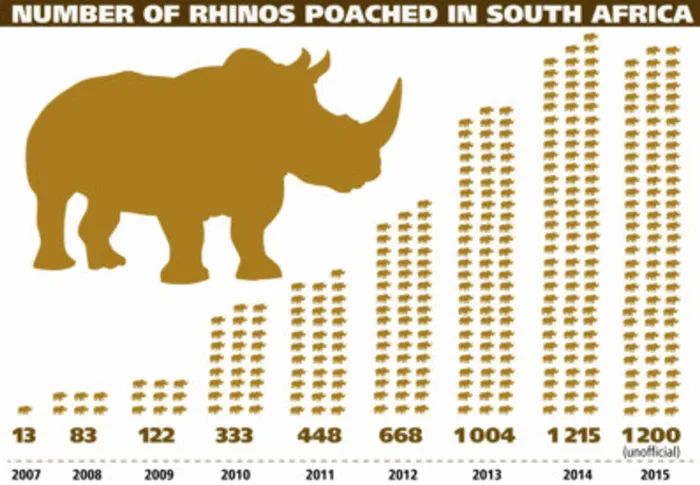Rate of rhino horn poaching may be slowing

For the first time in almost a decade, the rate of rhino horn poaching in South Africa may be slowing down – or even dropping very slightly.
Unofficial statistics suggest that when poachers fire the last bullet of the year at midnight today, close to 1 200 rhinos will have been slaughtered nationwide during 2015.
This is very slightly less than the 1 215 rhinos killed for their horns in 2014. While rhino conservation experts say the current killing rate remains “alarmingly high”, the latest trends point towards gradual success in slowing down the ever-rising poaching trend that began to sky-rocket from 2008, when 80 rhinos were slaughtered (see graphic).
Prior to that, killings seldom rose above 20 rhinos each year.
The Department of Environmental Affairs, which used to release poaching statistics monthly, has not released any official statistics since August (when 750 rhinos were confirmed poached in the first eight months of the year).
Early last year, when rhino deaths hit an all-time record in a nation that is custodian to more than 70 percent of the world’s remaining rhinos, the department began to stifle the regular release of poaching statistics.
However, unofficial statistics published online by the Stop Rhino Poaching Now campaign, suggest that the death toll reached 1 071 at the end of November and was projected to reach 1 174 deaths by year end.
Senior Environmental Department officials declined to comment on these figures last night or to provide updated official figures.
However, the apparent plateau in poaching for 2015 coincides with a series of heightened security interventions in the Kruger National Park and other rhino reserves.
Last year, for example, more than 100 rhinos were moved out of Kruger’s poaching hot spots to other more secure sanctuaries in South Africa and neighbouring states.
Within Kruger, a new “intensive protection zone” was also established in the central area of the park, while more rangers and security personnel have been supplied with night-vision goggles and other sophisticated technology to confront up to 12 poaching gangs operating in the park at any given time.
But a new draft report on global efforts to reduce rhino poaching has lamented the lack of “meaningful results” in the fight against transnational criminal gangs behind the lucrative horn trade.
The report acknowledges growing efforts in several nations to halt black market horn trading. “However, despite the increased resources devoted to law enforcement efforts, the number of rhinos poached continues to increase, so clearly an effective solution requires more than this.”
While several new initiatives were under way, “we need to see rapid and effective implementation of these measures”.
The Cites working group report notes an apparent new trend by smugglers that involves crushing rhino horn into a powder to avoid detection at security checkpoints.
Cites officials maintain that Vietnam remains the biggest end-user of illegal horns.
Vietnam recently submitted a report to Cites detailing efforts to curb illegal horn trading.
A separate report to Cites by the Department of Environmental Affairs notes that no Vietnamese nationals have been allowed to hunt rhinos in this country since 2012.
Czech hunters have also been banned.